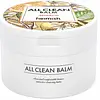What's inside
What's inside
 Key Ingredients
Key Ingredients

 Benefits
Benefits

 Concerns
Concerns

 Ingredients Side-by-side
Ingredients Side-by-side

Ethylhexyl Palmitate
EmollientCetyl Ethylhexanoate
EmollientPEG-20 Glyceryl Triisostearate
EmollientSynthetic Wax
AbrasivePEG-8 Isostearate
EmulsifyingArtemisia Vulgaris Oil
PerfumingCitrus Aurantium Amara Leaf/Twig Oil
MaskingLavandula Angustifolia Oil
MaskingLitsea Cubeba Fruit Oil
MaskingLaurus Nobilis Leaf Extract
MaskingCetyl PEG/PPG-10/1 Dimethicone
Emulsifying1,2-Hexanediol
Skin ConditioningCurcuma Longa Root Extract
MaskingMelia Azadirachta Flower Extract
Skin ConditioningMelia Azadirachta Leaf Extract
Skin ConditioningCorallina Officinalis Extract
Skin ConditioningMelia Azadirachta Bark Extract
AntimicrobialMoringa Oleifera Seed Oil
EmollientOcimum Sanctum Leaf Extract
Skin ConditioningTocopheryl Acetate
AntioxidantEclipta Prostrata Extract
Skin ConditioningGlycerin
HumectantCeramide NP
Skin ConditioningPhytosphingosine
Skin ConditioningHydrogenated Lecithin
EmulsifyingOctyldodecanol
EmollientOleyl Alcohol
EmollientButyrospermum Parkii Butter
Skin ConditioningCandida Bombicola/Glucose/Methyl Rapeseedate Ferment
AntimicrobialGlycine Soja Sterols
EmollientTocopherol
AntioxidantCitrus Junos Fruit Oil
MaskingCitrus Unshiu Fruit Oil
EmollientWater
Skin ConditioningCitrus Reticulata Fruit Extract
Skin ProtectingButylene Glycol
HumectantCamellia Sinensis Leaf Extract
AntimicrobialVaccinium Macrocarpon Fruit Extract
AstringentCarica Papaya Fruit Extract
Skin ConditioningEthylhexyl Palmitate, Cetyl Ethylhexanoate, PEG-20 Glyceryl Triisostearate, Synthetic Wax, PEG-8 Isostearate, Artemisia Vulgaris Oil, Citrus Aurantium Amara Leaf/Twig Oil, Lavandula Angustifolia Oil, Litsea Cubeba Fruit Oil, Laurus Nobilis Leaf Extract, Cetyl PEG/PPG-10/1 Dimethicone, 1,2-Hexanediol, Curcuma Longa Root Extract, Melia Azadirachta Flower Extract, Melia Azadirachta Leaf Extract, Corallina Officinalis Extract, Melia Azadirachta Bark Extract, Moringa Oleifera Seed Oil, Ocimum Sanctum Leaf Extract, Tocopheryl Acetate, Eclipta Prostrata Extract, Glycerin, Ceramide NP, Phytosphingosine, Hydrogenated Lecithin, Octyldodecanol, Oleyl Alcohol, Butyrospermum Parkii Butter, Candida Bombicola/Glucose/Methyl Rapeseedate Ferment, Glycine Soja Sterols, Tocopherol, Citrus Junos Fruit Oil, Citrus Unshiu Fruit Oil, Water, Citrus Reticulata Fruit Extract, Butylene Glycol, Camellia Sinensis Leaf Extract, Vaccinium Macrocarpon Fruit Extract, Carica Papaya Fruit Extract
 Reviews
Reviews

Ingredients Explained
These ingredients are found in both products.
Ingredients higher up in an ingredient list are typically present in a larger amount.
Butylene Glycol (or BG) is used within cosmetic products for a few different reasons:
Overall, Butylene Glycol is a safe and well-rounded ingredient that works well with other ingredients.
Though this ingredient works well with most skin types, some people with sensitive skin may experience a reaction such as allergic rashes, closed comedones, or itchiness.
Learn more about Butylene GlycolEthylhexyl Palmitate, also known as octyl palmitate, is created from 2-ethylhexyl alcohol and palmitic acid. It is a fatty acid ester.
The fatty acid content of Ethylhexyl Palmitate makes it an emollient. Emollients help soften and hydrate your skin by trapping moisture within.
Ethylhexyl Palmitate is also used to help improve the texture of cosmetics. It helps other ingredient dissolve in products and help disperse ingredients more evenly.
You'll likely find this ingredient in sunscreen, as it is often used to mix UV-blocking ingredients such as avobenzone and ethylhexyl triazone.
It can also help stabilize the fragrances in a product as a fragrance fixative.
Ethylhexyl Palmitate can be used to substitute mineral oil.
Due to its high fatty acid content, it may not be fungal-acne safe.
Learn more about Ethylhexyl PalmitatePeg-20 Glyceryl Triisostearate comes from Isostearic Acid and glycerin.
It is an emollient, emulsifier, and gentle cleanser. As an emollient, it helps trap moisture to keep skin soft and hydrated. Emulsifiers help prevent ingredients from separating.
This ingredient is common in oil-based products. This is because it helps oil-ingredients be easily washed away without leaving a residue.
Peg-20 Glyceryl Triisostearate may not be fungal-acne safe.
Learn more about PEG-20 Glyceryl TriisostearateSynthetic Wax is created from fossil fuels such as natural gas. It is used to enhance texture, adjust pH, and as an occlusive.
It may also be used as an abrasive ingredient to exfoliate the skin.
Synthetic Wax may not be fungal acne safe.
Learn more about Synthetic WaxTocopheryl Acetate is AKA Vitamin E. It is an antioxidant and protects your skin from free radicals. Free radicals damage the skin by breaking down collagen.
One study found using Tocopheryl Acetate with Vitamin C decreased the number of sunburned cells.
Tocopheryl Acetate is commonly found in both skincare and dietary supplements.
Learn more about Tocopheryl AcetateWater. It's the most common cosmetic ingredient of all. You'll usually see it at the top of ingredient lists, meaning that it makes up the largest part of the product.
So why is it so popular? Water most often acts as a solvent - this means that it helps dissolve other ingredients into the formulation.
You'll also recognize water as that liquid we all need to stay alive. If you see this, drink a glass of water. Stay hydrated!
Learn more about Water